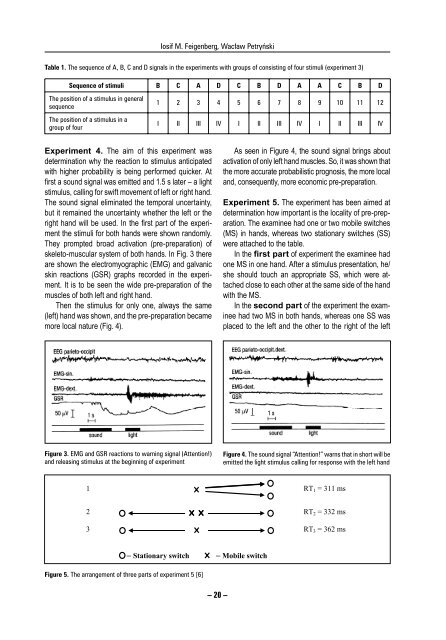Antropomotoryka nr 55.indb - Akademia Wychowania Fizycznego w ...
Antropomotoryka nr 55.indb - Akademia Wychowania Fizycznego w ...
Antropomotoryka nr 55.indb - Akademia Wychowania Fizycznego w ...
Create successful ePaper yourself
Turn your PDF publications into a flip-book with our unique Google optimized e-Paper software.
Iosif M. Feigenberg, Wacław Petryński<br />
Table 1. The sequence of A, B, C and D signals in the experiments with groups of consisting of four stimuli (experiment 3)<br />
Sequence of stimuli B C A D C B D A A C B D<br />
The position of a stimulus in general<br />
sequence<br />
The position of a stimulus in a<br />
group of four<br />
1 2 3 4 5 6 7 8 9 10 11 12<br />
I II III IV I II III IV I II III IV<br />
Experiment 4. The aim of this experiment was<br />
determination why the reaction to stimulus anticipated<br />
with higher probability is being performed quicker. At<br />
first a sound signal was emitted and 1.5 s later – a light<br />
stimulus, calling for swift movement of left or right hand.<br />
The sound signal eliminated the temporal uncertainty,<br />
but it remained the uncertainty whether the left or the<br />
right hand will be used. In the first part of the experiment<br />
the stimuli for both hands were shown randomly.<br />
They prompted broad activation (pre-preparation) of<br />
skeleto-muscular system of both hands. In Fig. 3 there<br />
are shown the electromyographic (EMG) and galvanic<br />
skin reactions (GSR) graphs recorded in the experiment.<br />
It is to be seen the wide pre-preparation of the<br />
muscles of both left and right hand.<br />
Then the stimulus for only one, always the same<br />
(left) hand was shown, and the pre-preparation became<br />
more local nature (Fig. 4).<br />
As seen in Figure 4, the sound signal brings about<br />
activation of only left hand muscles. So, it was shown that<br />
the more accurate probabilistic prognosis, the more local<br />
and, consequently, more economic pre-preparation.<br />
Experiment 5. The experiment has been aimed at<br />
determination how important is the locality of pre-preparation.<br />
The examinee had one or two mobile switches<br />
(MS) in hands, whereas two stationary switches (SS)<br />
were attached to the table.<br />
In the first part of experiment the examinee had<br />
one MS in one hand. After a stimulus presentation, he/<br />
she should touch an appropriate SS, which were attached<br />
close to each other at the same side of the hand<br />
with the MS.<br />
In the second part of the experiment the examinee<br />
had two MS in both hands, whereas one SS was<br />
placed to the left and the other to the right of the left<br />
Figure 3. EMG and GSR reactions to warning signal (Attention!)<br />
and releasing stimulus at the beginning of experiment<br />
Figure 4. The sound signal “Attention!” warns that in short will be<br />
emitted the light stimulus calling for response with the left hand<br />
1 RT 1 = 311 ms<br />
2<br />
3<br />
RT 2 = 332 ms<br />
RT 3 = 362 ms<br />
– Stationary switch – Mobile switch<br />
Figure 5. The arrangement of three parts of experiment 5 [6]<br />
– 20 –





![Antropomotoryka nr 57 [2012]. - Akademia Wychowania Fizycznego ...](https://img.yumpu.com/50213388/1/182x260/antropomotoryka-nr-57-2012-akademia-wychowania-fizycznego-.jpg?quality=85)











